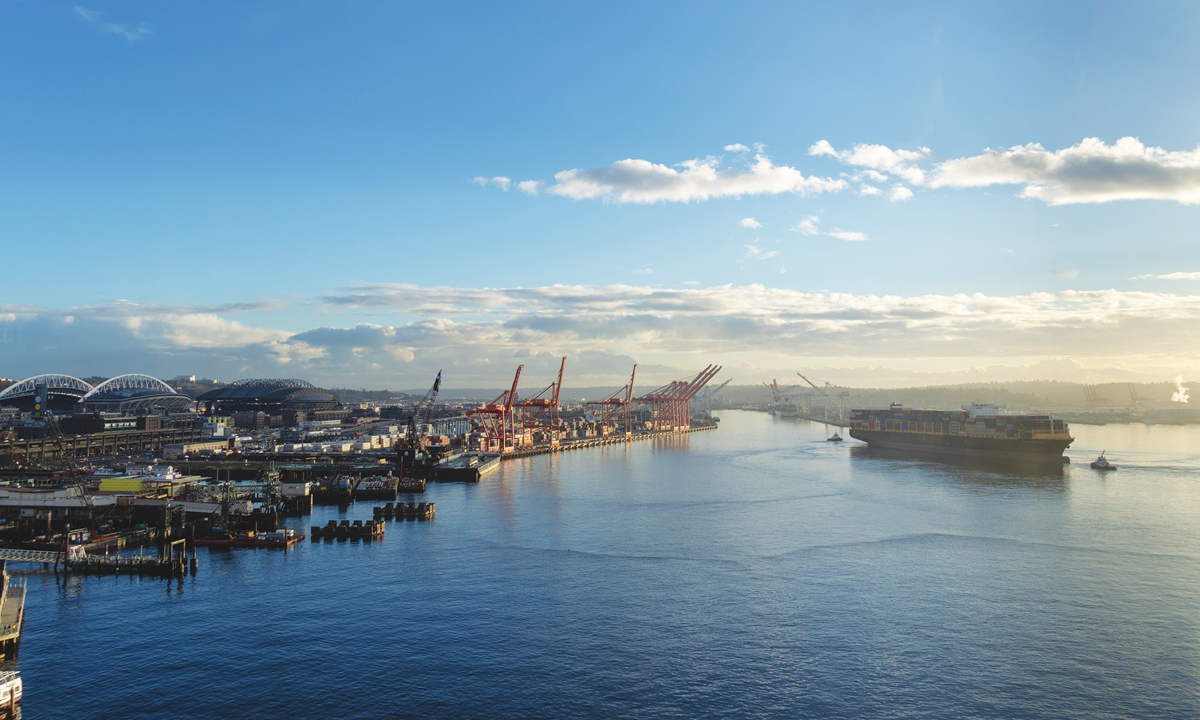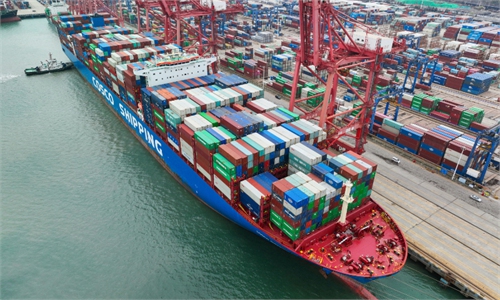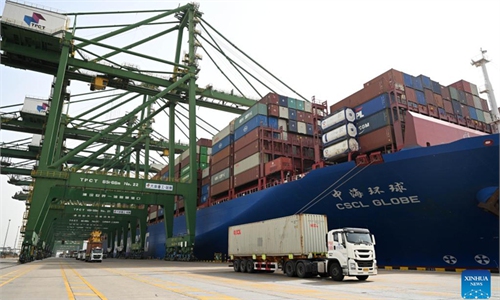US ports strikes continue to snarl international trade flow; Washington's 'decoupling' policy casts cloud on trans-Pacific commerce

A view of the Seattle port Photo: VCG
In a sign of renewed volatility, the workers walkouts at multiple ports along the US west coast have again snarling global shipping routes, including critical trans-Pacific routes between China and the US.
Experts warn that the prolonged labor dispute has the potential to impede economic recovery and disrupt the stability of global supply chains, urging the US side to reach an agreement as soon as possible to minimize the impact for the stable operation of the global supply chain.
With sea freight rates, order scheduling, and vessels' waiting time all thrown into disarray, businesses are finding themselves compelled to adopt a "wait-and-see" approach. The situation of the US workers strike is further compounded by the draught at the Panama Canal and the coinciding annual peak period of global trade in the third quarter, intensifying concerns, experts said.
Over the weekend, the Pacific Maritime Association (PMA), representing the ports, announced that cargo operations at the Port of Seattle are shut down. The PMA said in their previous announcement that similar union actions have shut down or significantly impacted dock operations in Oakland, Tacoma, Seattle, and Hueneme ports.
While the prolonged labor dispute between the port operator and the union have been ongoing for months, it has caused port operation disruptions, including at some key entry points for Asian imports in the US, including Los Angeles, Long Beach, Oakland, and Seattle. These ports are the busiest in the US and play a crucial role in handling trade with China.
Port workers strike
The US media has long blamed Chinese port congestion for hindering US port operations. However, industry experts argue that it is actually the strikes in American ports that have been the main culprit.
Since last July, more than 22,000 port workers at nearly 30 ports across the US west coast have been working without contracts, causing occasional closures by not showing up to work, the Washington Post reported. The labor dispute comes amid record profits earned by port operators. The International Longshore and Warehouse Union (ILWU) claims that port operators made $510 billion during the pandemic, but those earnings have not been passed down to dockworkers, the report said.
The PMA, which represents port operators and shipping companies in labor contract negotiations, alleges that the union has been involved in "concerted and disruptive work actions" since June 2. These actions reportedly include "refusing to dispatch workers to marine terminals, slowing operations, and making unfounded health claims."
Experts said that the impact of the port labor strikes could negatively impact normal global trade activities, particularly on China-US trade.
For example, the Seattle Port is the closest US port to the Far East. In 2022, the major trading partners with the US through this port included China, Japan, Vietnam, the Philippines, and other Asian economies. Trade ranging from agricultural products to automobiles is likely to be affected to varying degrees.
Growing fluctuations
Meanwhile, the Port of Auckland as a whole is in the severe congestion phase, has reached an average congestion index of 0.92, and is expected to wait more than 40 hours, a recent data that shipping big data company Elane sent to the Global Times showed.
Driven by the impact, the freight rates between China and the US experienced significant fluctuations.
On June 2nd, the market freight rates for exports from Shanghai Port to US west coastal ports were $1,666 per FEU (forty-foot equivalent unit), an increase of 19.2 percent compared to a week ago. However, on Friday, the figure saw a notable decline of 16.7 percent from a week ago, indicating fairly large fluctuations in the short term.
And, the negotiations on labor conditions remain deadlocked, with the possibility of further prolongation or escalation, Kang Shuchun, a director at the China Federation of Logistics and Purchasing, told the Global Times. Additionally, the Panama Canal is facing new drought restrictions, making it difficult for large vessels from Asia to the US' east coast to navigate the canal.
"This situation has led to a significant increase in transportation costs and a decrease in available shipping capacity," Kang said.
The increase in freight costs has further dampened the outlook for China-US trade, and together with the US government's decoupling push, it has resulted in a decrease in Chinese exports to America.
Prolonged labor dispute
The ongoing labor dispute between port owners and workers, the most prolonged disruption of its kind since 2015, is nearing the one-year mark without reaching a compromise deal.
Zhong Zhechao, founder of One Shipping, an international logistics service consulting firm, told the Global Times that the US port strikes have been a long-standing issue in the country's history that not only showcases the strength of the dockworker unions, but also highlighting the inadequate infrastructure development of American ports.
The port strike comes as port construction and management have failed to keep up with the increasing demand for port services driven by the growth in US trade, Zhong said.
Experts said that what happened at the US west coast may serve as an example of how Chinese ports are more efficient in responding to today's global trade changes. China, with seven of the world's top 10 ports, not only serves as a primary global trade hub but also boasts efficient port operations.
Even during the peak of the COVID19 outbreak in April, 2022, the average waiting time for container ships at the Shanghai Port was less than 24 hours. The Shanghai Port Group said that, except for extreme weather conditions, all production units at the port maintained normal operations for 24 hours during that special period. The high automation rate is an important factor.
In contrast, congestion at US ports could cause ships to wait for weeks before loading or unloading.
"Chinese ports are occasionally affected by uncontrollable factors like extreme weather or a pandemic. Meanwhile, the US port congestion is mainly caused by human factors, such as outdated infrastructure and strikes," Zhong said.
But, some Western media have shown biases in their coverage of Chinese ports. For instance, when China temporarily suspended operations at some ports due to pandemic prevention requirements, they portrayed it having a significant impact on global supply chain. But very often it is the US that directly impacts the global supply chain due to its port strikes, Zheng Jingwen, a research fellow at the Shanghai International Shipping Research Center, told the Global Times.


